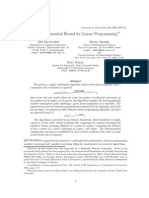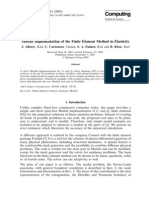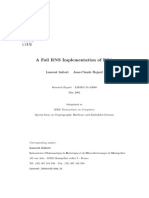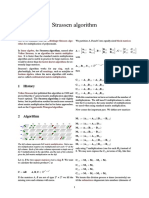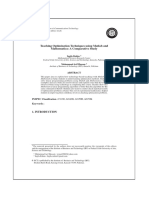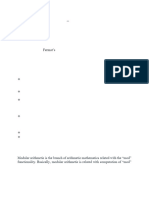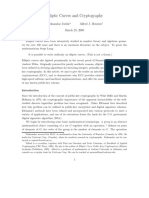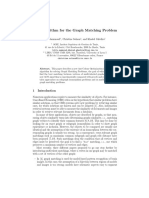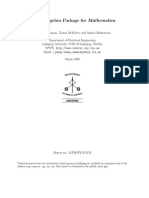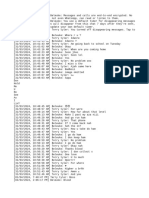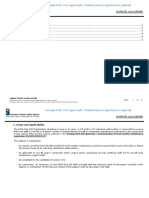Implementing The RSA Cryptosystem With Maxima CAS
Implementing The RSA Cryptosystem With Maxima CAS
Uploaded by
joaquin murgadeCopyright:
Available Formats
Implementing The RSA Cryptosystem With Maxima CAS
Implementing The RSA Cryptosystem With Maxima CAS
Uploaded by
joaquin murgadeOriginal Title
Copyright
Available Formats
Share this document
Did you find this document useful?
Is this content inappropriate?
Copyright:
Available Formats
Implementing The RSA Cryptosystem With Maxima CAS
Implementing The RSA Cryptosystem With Maxima CAS
Uploaded by
joaquin murgadeCopyright:
Available Formats
The Electronic Journal of Mathematics and Technology, Volume 6, Number 1, ISSN 1933-2823
Implementing the RSA cryptosystem with Maxima CAS
Juan Monterde Jos A. Vallejo e monterde@uv.es jvallejo@fc.uaslp.mx Facultat de Matem` tiques a Facultad de Ciencias Universitat de Val` ncia Universidad Aut noma de San Luis Potos e o Spain M xico e
Abstract We show a possible implementation of the RSA algorithm with Maxima CAS. Theoretical background and numerous examples are given, along with the code. We also implement a simplied version of the digital signature method and comment on some ideas for using this material in the classroom.
Introduction
A basic problem in cryptography is the reduction of the number of operations needed to deal with big numbers. This is usually done through the use of congruences. An example is the RSA algorithm, in which calculations are done modulo n, where n is the product of two (big) primes p and q. In practical applications, the size in bits of n is 1024, 2048 or even 4096 (corresponding to 309, 617 and 1234 decimal digits, respectively). Thus, the computational cost if we were to use these numbers as they are would be prohibitive. One possibility is to make use of the Chinese remainder theorem, so the calculations can be transferred from the ring Zn to the ring Zp Zq . The sum of the bit length of p and q is the bit length of n, so p and q can be taken considerably smaller than n, and the calculations are speeded up notably. The reason behind these properties is that the Chinese remainder theorem allows one to represent big integers as ntuples of long (Euclidean) divisions remainders. In this form, operations such as sums or multiplications can be done in parallel in real time. However, comparison or division are not so direct, and the inverse problem (given n factoring it into p and q) is computationally intractable for large n. Precisely, this fact lies at the foundation of the RSA algorithm [7]. However, when using RSA encryption one has to compute expressions of the form ab mod c, with large a, b. For these, the Chinese remainder theorem is not so practical, and other algorithms are preferred, such as the repeated squaring method. From a mathematical point of view, the other essential ingredients of the RSA cryptosystem are Fermats Little Theorem and its generalization, Eulers theorem on congruences. These facts will be reviewed in Section 2. Our aim in this paper is to show how to implement the RSA cryptosystem with the Maxima CAS [4], which we do in Section 3. This choice of software is motivated by pedagogical as well as practical reasons: the source code is freely available, the students can get a copy at no cost (thus, they
The Electronic Journal of Mathematics and Technology, Volume 6, Number 1, ISSN 1933-2823
can work at home with the same program they use at the classroom), the developers are very active and accessible, and the commands and syntax are very intuitive (some of the Maxima syntax is merely a translation of the plain English used to describe the mathematical operations, such as integrate(x2,x,0,1): integrate x2 with respect to x between 0 and 1). These reasons almost coincide with the ones expressed by A. McAndrew in [5], a paper which describes in great detail the use of Maxima and Axiom in teaching a course on cryptography (for an interesting alternative, see also [6], where SAGE is used instead of Maxima). Indeed, the present paper is based on a 10hour summer course given by one of the authors (JM) to students of mathematics, physics and engineering, ranging from rst-year to post-graduates. Our conclusions are also similar to those of McAndrew in [5] (Maxima is particularly well suited for basic cryptography), so we refer to his paper for a justication of the educational aspects and focus our attention on the technical details: the mathematical foundation of the RSA cryptosystem and its practical implementation on Maxima. In Section 4 we show how to apply the RSA techniques to guarantee the authorship of a message, through the use of digital signatures. We include sample codes for all the functions described in the text along with examples of their usage, so the paper is relatively self-contained. Information about the use of Maxima can be found in the page http://maxima.sourceforge.net/ documentation.html. Section 5 offers some comments about how to use the present material in actual cryptography courses. Some technical details about the software used: The version of Maxima was 5.24.0, with the interface wxMaxima (version 11.04.0). Both can be downloaded for free from http://maxima.sourceforge.net/download.html and http://andrejv.github.com/wxmaxima, respectively. The code examples assume that the messages are written in pure ASCII (not extended), to avoid some problems with the XML rendering of non printable characters in wxMaxima. When expressing the path to a le, we assume that the user has a Linux R or Mac OSX R system. For MS Windows R , little changes are required. The source code for the programs presented in this paper, suppressed outputs and some related material, can be found at http://galia.fc.uaslp.mx/jvallejo/Software.html.
2
2.1
Algebraic preliminaries
Modular arithmetic
We begin by recalling Euclids algorithm. To compute the greatest common divisor (gcd) of two integers a, b Z, rst divide a by b to nd the quotient q1 and the remainder r1 : a = q1 b + r1 . Then, repeat the process substituting a by b and b by r1 : b = q2 r1 + r2 . Repeat again, this time using r1 and r2 , to nd: r1 = q3 r2 + r3 .
35
The Electronic Journal of Mathematics and Technology, Volume 6, Number 1, ISSN 1933-2823
The algorithm continues this way until one of the ri divides ri1 . In this case, gcd(a, b) = ri1 . Note that the process ends after a nite number of steps, as in each one of them we have ri < ri1 . Example 1 To compute gcd(1547, 560), we proceed as follows: 1547 = 2 560 + 427; 560 = 1 427 + 133; 427 = 3 133 + 28; 133 = 4 28 + 21; 28 = 1 21 + 7. As 7|21, we are done: gcd(1547, 560) = 7. Maxima has a function to compute the gcd: (%i1) gcd(1547,560); (%o1) 7
A basic fact from Number Theory is the following: If d = gcd(a, b), with a > b, there exist two integers u, v such that d = ua + vb. This is called the B zout identity (see [2], Section 1.2). e Example 2 We have just seen that gcd(1547, 560) = 7. Let us nd u, v such that 7 = u1547+v560. We can use the intermediate steps in Euclids algorithm, but reversing direction (from end to start): 7 = = = = = Thus, 7 = 21 1547 58 560. The Maxima command gcdex does the same: (%i2) gcdex(1547,560); (%o2) [21, 58, 7] 28 1 21 28 (133 4 28) = 133 + 5 28 133 + 5 (427 3 133) = 5 427 16 133 5 427 16 (560 427) = 16 560 + 21 427 16 560 + 21 (1547 2 560) = 21 1547 58 560.
As a direct application of the B zout identity, we have that the invertible elements for the product e in Z/mZ, are precisely those coprimes with m. In other words: the integers a for which there exists a b such that ab 1 (mod m), are precisely those a satisfying gcd(a, m) = 1.
1
This is the ring formed by the equivalence classes determined by the binary relation congruence modulo m: two integers a, b Z are congruent modulo m iff their difference ab is a multiple of m. In this case we write a b (mod m).
36
The Electronic Journal of Mathematics and Technology, Volume 6, Number 1, ISSN 1933-2823
Example 3 Modulo 841, the integer 160 is invertible. Indeed, 841 = 292 while 160 = 25 5. Thus, gcd(841, 160) = 1. Its inverse is 205, since 160 205 1 = 32800 1 = 32799 = 39 841. Maxima can compute the inverse of n modulo m directly with the command inv mod: (%i3) inv_mod(160,841); (%o3) 205
The properties of modular arithmetic are similar to those of integer arithmetic. To name a few (see [1], Chapter 5): 1. a a (mod m), for all a Z. 2. a b (mod m) if and only if b a (mod m), for all a, b Z. 3. If a b (mod m) and b c (mod m), then a c (mod m), for all a, b, c Z. 4. If a b (mod m) and c d (mod m), then a + c b + d (mod m) and a c b d (mod m), for all a, b, c, d Z. 5. If a b (mod m), then if a b (mod d) for each divisor of m, d. 6. If a b (mod m), and a b (mod n), with m, n coprimes, then a b (mod m n). We now recall a classical result (see [1], Chapter 5). Fermats Little Theorem says that if p is a prime number, then for any integer a we have ap a (mod p), and, for every integer a not divisible by p: ap1 1 (mod p). (1)
An immediate consequence is the following. If a is not divisible by p and n m (mod (p 1)), then an am (mod p).
Example 4 Let us nd the last digit of 21000000 when written in base 7. This is just the remainder of 21000000 modulo 7. In order to apply the result above, we must reduce the exponent. If we take p = 7, n = 1000000, we must nd a suitable m such that 1000000 m (mod 6). Since 1000000 = 166666 6 + 4, this means that we can take m = 4. Applying now the corollary to Fermats Little Theorem, we nd 21000000 24 = 16 2 (mod 7). Thus, the last digit of 21000000 when written in base 7 is 2.
37
The Electronic Journal of Mathematics and Technology, Volume 6, Number 1, ISSN 1933-2823
2.2
The Chinese remainder theorem
The original form of the theorem, appearing in a book written by the Chinese mathematician Qin Jiushao and published in 1247, is a result related to systems of congruences. It is possible to nd a precedent in the Sunzi suanjing, a book from the third century written by Sun Zi: Han Xing asks how many soldiers are in his army. If you let them parade in rows of 3 soldiers, two soldiers will be left. If you let them parade in rows of 5, 3 will be left, and in rows of 7, 2 will be left. How many soldiers are there?. The modern formulation of the problem is the following. Let m1 , m2 , ..., mk be integers that are greater than one and pairwise coprime, and let a1 , a2 , ..., ak be any integers. Then there exists an integer x such that x ai (mod mi ) for each i {1, 2, ..., k}. Furthermore, for any other integer y that satises all the congruences, y x (mod M ) where M = m1 mk . Note that there is only one solution in {0, 1, ..., M }. The proof of the theorem (which can be found in Theorem 5.26 of [1]) gives an algorithm to nd x. The following code implements it in Maxima (it returns the lowest positive solution modulo M ):
Beginning of code chinese_remainder(a,k):= block([K,L,x], K:makelist(apply("*",delete(k[i],k)),i,1,length(k)), L:makelist(first(gcdex(K[i],k[i])),i,1,length(k)), x:mod(sum(a[i]*K[i]*L[i],i,1,length(k)),apply("*",k)), x ); End of code
To use it, just write chinese remainder([a1,...,ar],[m1,...,mr]). For the Han Xings example: (%i4) chinese_remainder([2,3,2],[3,5,7]); (%o4) 23
A small army, indeed. Surely, this is one example in which the solution is not the one in {0, 1, ..., M } (as in this case Han Xing would have not needed to ask for the number of soldiers, being easy to count them by himself), but one of the innite numbers congruent with 23 modulo M = 7 5 3 = 105, that is: 128, 233, etcetera.
2.3
Eulers theorem
Consider Example 4 again. What if we are asked for the last digit in base 77?. We can not apply Fermats theorem here, because 77 is composite. Euler found a generalization of Fermats theorem to this case, introducing his totient function (n) (which gives the number of positive integers less than
38
The Electronic Journal of Mathematics and Technology, Volume 6, Number 1, ISSN 1933-2823
or equal to n that are coprime to n). In Maxima we have the command totient: (%i5) totient(77); (%5) 60
Now, Eulers theorem says that for every a Z: a(n) 1 (mod n).
Example 5 Let us compute the last digit of 21000000 in base 77. As (77) = 60, we know that 260 1 (mod 77). As 1000000 = 16666 60 + 40, then 21000000 240 (mod 77). Now, it is easy to compute 240 (mod 77). For instance 210 = 1024 = 13 77 + 23 23 (mod 77), and 240 = 2104 = 234 23 (mod 77). Thus, the last digit of 21000000 in base 77 is 3.
2.4
The Maxima function power mod
As we have seen in Example 5, a basic computation one often encounters in modular arithmetic is the modular exponentiation when both the exponent and the modulus are very large. As mentioned, the Chinese remainder theorem or the Eulers theorem can be of some help to compute modular exponentiation. Nevertheless, there is in Maxima a simple way to compute such exponentiation without using these results. The modular power function power mod(a,b,c) gives exactly the result of ab (mod c) for b > 0: (%i6) power_mod(2,40,77); (%o6) 23
However, power mod is much more efcient than the Chinese remainder or Eulers theorems, because it avoids generating the full form of ab . The algorithm to compute modular exponentiation follows the repeated squaring method: Instead of repeated multiplication of a by itself, what this algorithm does is to reduce any partial result modulo c, immediately after a multiplication is performed. In that way we never encounter any integers greater than c2 (see [8] for details on this method). In our implementation of the RSA cryptosystem we will use the power mod function, and so, the repeated squaring method implicitly.
39
The Electronic Journal of Mathematics and Technology, Volume 6, Number 1, ISSN 1933-2823
3
3.1
The RSA cryptosystem
Caesar cipher
The rst documented cryptosystem is very simple. It just replaces each letter in the plain text with the one sitting three positions down the alphabet, for example, we would replace A by D, B by E, and so on (the last three letters, X, Y, Z, are replaced by A, B, C, respectively). It seems that this method was used by Julius Caesar to send military instructions to his generals. This idea can be translated to numbers, for an easier use. If we replace each letter of the alphabet by a natural number (adding the space between words character) as in a 1 b c 2 3 d e 4 5 f 6 g h i 7 8 9 j 10 k 11 l 12 r 18 s 19 t 20 u 21 v 22 w 23 x 24 y 25 z 26
then the encryption function is simply f (x) = x + 3 (mod 27), while the decryption function is, obviously, the inverse: g(x) = f 1 (x) = x 3 (mod 27). These simple properties make the Caesar cipher very easy to use. However, they are also the origin of its weakness. To break a cryptosystem means to deduce the encryption/decryption functions from a sample of ciphertext (the encrypted message); in this case, the method of attack is a simple frequency analysis of word repetitions (in English, for instance, the most repeated number corresponds to the most used letter, the e, the second is the t, and so on). Several schemes were devised to improve the Caesar cipher. For instance, one could try more complicated bijections, such as f (x) = a x + b (mod 27), with a an integer such that gcd(a, 27) = 1, and a, b {1, 2, ..., 26}. Another possibility consists in taking groups of contiguous letters, instead of one by one; for example, digraphs (groups of two letters) or trigraphs (groups of three letters). In this case, an encryption function could have the form f (x) = a x + b (mod m), where a, b {1, 2, ..., m 1} and m is a number big enough to allow for the enumeration (in a one-to-one and onto manner) of every possible combination of three characters. Both parameters, a and m, are necessary for the encryption as well as the decryption processes, and are called the key of the cryptosystem. Anyway, these systems are too weak to be used in practice. They can be broken in a number of ways, very easily with the use of a modern computer. We have cited them here just for the sake of illustration of the concepts involved.
40
The Electronic Journal of Mathematics and Technology, Volume 6, Number 1, ISSN 1933-2823
3.2
Public key cryptosystems
A revolution happened when the so called public key cryptosystems appeared, in the late seventies. These systems are based on the following fact: there are bijective (one-to-one and onto) functions for which the calculation of the inverse is very difcult, computationally impossible. Then, we can make publicly available the keys used to encrypt messages whenever the keys used for decryption are to be found by one of these functions. One example is the factorization of a given number into a product of primes, and this fact is the foundation of the RSA method (see [7]). In a public key cryptosystem, each user has a public key, that is, an encryption function fpub , and 1 a private key, a decryption function fpri , which are inverses one of another: fpri = fpub . Thus, if a user A wants to send a message (say, text, translated to numbers as in the preceding section to 2052420) to a user B, she must look in the public keys listing the one corresponding to B (say, B B fpub ), apply it to the message (obtaining fpub (2052420)), and send it to B. Even in the unfortunate event that someone intercepts the ciphered text, only B knows the decryption function. Indeed, user B B 1 B B can read the original message by just applying fpri = fpub to fpub (2052420); thus:
B B B fpri fpub (2052420) = fpub 1 B fpub (2052420) = 2052420.
3.3
The RSA algorithm
As stated in the preceding subsection, to implement the RSA cryptosystem we only need to give the pair of functions (fpub , fpri ) for each user, A, of the system. The procedure is the following: 1. User A chooses two large prime numbers, pA and qA . 2. Calculate the product nA = pA qA . 3. Evaluate the totient function2 on nA , (nA ) 4. Choose a number eA {1, 2, ..., (nA )}, coprime with (nA ). With these choices, gcd(eA , (nA )) = 1, so eA is an invertible element of the ring Z/(nA )Z. Let dA be an integer such that its equivalence class is the inverse of that of eA , that is, eA dA 1 (mod (nA )).
A 5. The encryption function, fpub : Z/nA Z Z/nA Z, is given by A fpub (m) = meA (mod nA ).
2
Note that in this case, with nA semiprime (that is, the product of two primes), we have (nA ) = (pA 1) (qA 1) = nA pA qA 1.
41
The Electronic Journal of Mathematics and Technology, Volume 6, Number 1, ISSN 1933-2823
A A 6. The decryption function, fpri , is the inverse of fpub , that is: A fpri (m) = mdA (mod nA ).
It is instructive to check that these functions are indeed inverses of each other. Theorem 6 For every m Z/nA Z,
A A A fpri (fpub (m)) fpri (meA ) meA dA m (mod nA ).
Proof. For simplicity, we will drop the subscripts A. We can assume that m is not divisible3 by p. Then, by Fermats Little Theorem (1), mp1 1 (mod p). Let us take the power of q 1 on both sides of this equation: m(p1)(q1) = mp1
q1
1q1 = 1 (mod p).
A similar computation, interchanging p and q, gives m(p1)(q1) = mq1
p1
1p1 = 1 (mod q).
We can apply the property 6 of modular arithmetic, to get m(p1)(q1) = 1 (mod pq). Note that for any integer k we will also have mk(p1)(q1) = m(p1)(q1)
k
1k = 1 (mod pq).
Now, recall that e d 1 (mod (n) = (p 1) (q 1)). That means e d = 1 + k (p 1) (q 1). Thus: med = m1+k(p1)(q1) = m mk(p1)(q1) m 1 = m (mod pq), so med m (mod n), as we intended to prove. Why is this method secure?. In the RSA cryptosystem, the public key of user A is the pair of integers (eA , nA ), while her private key is the pair (dA , nA ). To nd the private key knowing the public key is equivalent to computing the integer dA knowing eA and nA . Thus, if we want to break the cryptosystem, we must rst calculate (nA ) = (pA 1)(qA 1), that is, we must factor nA as the product of two primes. This is an extremely difcult problem from the computational point of view; indeed, a joint effort of several researchers using hundreds of dedicated computers only could factor a 232digit number after two years of computation (see [3]). Note that this number corresponds to a 768bit encryption, the problem of factoring a 1024bit key is a thousand times harder! Thus, although breaking the RSA cryptosystem is theoretically possible, it is practically impossible with our current state of knowledge.
3
That p divide m is highly improbable, given the magnitude order of the prime p.
42
The Electronic Journal of Mathematics and Technology, Volume 6, Number 1, ISSN 1933-2823
3.4
Implementation in Maxima CAS
The following function generates a list (e, n, d) suitable for use in the RSA algorithm.
Beginning of code ( load(distrib) ); generate_random_key(l):= block([p,q,n,r,e,d,K], p:next_prime(floor(float(random_continuous_uniform(2l,2(l+1))))), q:next_prime(floor(float(random_continuous_uniform(2l,2(l+1))))), n:p*q, r:(p-1)*(q-1), e:next_prime(floor(float(random(floor(r/2))))), d:inv_mod(e,r), K:[e,n,d], K ); End of code
To use it write generate random key(l) where l determines the number of digits of the integers e, n, d (they will be pseudo-randomly generated between 2l and 2l+1 ). A suggested value (to speed up computations while keeping practical interest for applications) is l = 125. Note that the construction of e is based on the obvious consequence of the Prime Number Theorem4 that the number of primes between r/2 and r (for large r) is approximately r/log(r/2), so these are relatively abundant. For example: (%i7) key:generate_random_key(125); (%o7) [671258217454686505293403265373669737061769832160804966205145423006710890659, 6524380046621073928456206976859918286968722163998541593398840097117692758107, 4117416708352497196549341588732382167090260042357291528574523538009688319619] Once we have the list (e, n, d) as the output of generate random key, we can create our public key (e, n): (%i8) public_key:rest(key,-1); (%o8)
4
[671258217454686505293403265373669737061769832160804966205145423006710890659,
Let (x) be the function giving the number of primes less than or equal to x. Then, the Prime Number Theorem says (x) = 1. x+ x/ln(x) lim
that
43
The Electronic Journal of Mathematics and Technology, Volume 6, Number 1, ISSN 1933-2823
6524380046621073928456206976859918286968722163998541593398840097117692758107] and our private key (d, n): (%i9) private_key:reverse(rest(key,1)); (%o9) [4117416708352497196549341588732382167090260042357291528574523538009688319619, 6524380046621073928456206976859918286968722163998541593398840097117692758107] The next function rsa encrypt reads a text from a le and encrypts it in blocks of length k.
Beginning of code ( load(stringproc) ); file_to_string(u):= block([a,i:0,text_string,tmp], a:openr(u), while stringp(tmp[i]:readline(a)) do i:i+1, text_string:simplode(makelist(tmp[j],j,0,i-1)," "), text_string ); rsa_encrypt_console(s,k,P):= block([tmp,added_char,encrypted_text,encrypted_text_added], local(fill_string,string_to_number,rsa_encode), tmp:smake(k-(slength(s)-k*floor(slength(s)/k)),ascii(126)), added_char:[slength(tmp)], fill_string(s,k):=concat(s,tmp), string_to_number(s):=sum( (cint(charat(s,i))-32)*95(i-1),i,1,slength(s) ), rsa_encode(a,b,c):=power_mod(a,b,c), encrypted_text:makelist( rsa_encode( string_to_number( substring(fill_string(s,k), 1+k*(i-1), 1+k*i) ),P[1],P[2] ), i, 1, slength(fill_string(s,k))/k ), encrypted_text_added:append(added_char,encrypted_text) ); rsa_encrypt_file(s,k,P,p):= block([LL], LL:rsa_encrypt_console(s,k,P),
44
The Electronic Journal of Mathematics and Technology, Volume 6, Number 1, ISSN 1933-2823
stringout(p,LL) ); rsa_encrypt(q,k,P,[p]):= block([t], t:file_to_string(q), if p=[] then rsa_encrypt_console(t,k,P) else rsa_encrypt_file(t,k,P,first(p)) ); End of code
The result can be shown in the console or, if a path to a le is given, written to that le. For the purpose of this example, we have stored the following text in /root/hysteria.txt: As she laughed I was aware of becoming involved in her laughter and being part of it, until her teeth were only accidental stars with a talent for squad-drill. I was drawn in by short gasps, inhaled at each momentary recovery, lost nally in the dark caverns of her throat, bruised by the ripple of unseen muscles. An elderly waiter with trembling hands was hurriedly spreading a pink and white checked cloth over the rusty green iron table, saying: If the lady and gentleman wish to take their tea in the garden, if the lady and gentleman wish to take their tea in the garden ... I decided that if the shaking of her breasts could be stopped, some of the fragments of the afternoon might be collected, and I concentrated my attention with careful subtlety to this end. We can encrypt the text in blocks of length5 k = 20 with the following commands (the output is suppressed because of its length): (%i10) load(rsa_encrypt)$ (%i11) rsa_encrypt("/root/hysteria.txt",20,public_key); Or we can redirect the output to a le, in this example /root/hysteria-encrypted.txt: (%i12) rsa_encrypt("/root/hysteria.txt",20,public_key, "/root/hysteria-encrypted.txt"); (%o12) /root/hysteria encrypted.txt The function given below, rsa decrypt, reads encrypted text from a le and decrypts it.
Beginning of code ( load(basic) );
Here, the particular value k = 20 is chosen just as an example. In Section 5, k = 3 is taken instead. What one should keep in mind when choosing the value of k is that the numerical representation of each block must have a value less than the modulus if the message is to be decrypted successfully.
5
45
The Electronic Journal of Mathematics and Technology, Volume 6, Number 1, ISSN 1933-2823
rsa_decrypt_console(M,k,Q):= block([clean_message],local(number_to_string,rsa_decode), number_to_string(z,k):=makelist( ascii(mod(floor(z/(95(i-1))),95)+32),i,1,k ), rsa_decode(a,b,c):=power_mod(a,b,c), clean_message:simplode( makelist( simplode( number_to_string( rsa_decode(M[i],Q[1],Q[2]),k ) ) ,i,1,length(M)) ), clean_message ); rsa_decrypt(s,k,Q,[p]):= block([prelist,AA,BB,len], prelist:read_list(s,comma), AA:rest(rest(prelist,-2),1), BB:pop(AA), len:slength(rsa_decrypt_console(AA,k,Q)), if p=[] then substring(rsa_decrypt_console(AA,k,Q),1,len-(BB-1)) else stringout( first(p),substring( rsa_decrypt_console(AA,k,Q),1,len-(BB-1) ) ) ); End of code
Again, the function can show the clean text in the console or, if a path to a le is given, to store the decrypted text in that le. In the example, we decode the text that was previously encrypted and stored in /root/hysteria-encrypted.txt. Note also that the length of the blocks (k = 20) is passed as an argument: (%i13) rsa_decrypt("/root/hysteria-encrypted.txt",20,private_key); (%o13) As she laughed I was aware of becoming involved in her laughter and being part of it, until her teeth were only accidental stars with a talent for squad-drill. I was drawn in by short gasps, inhaled at each momentary recovery, lost nally in the dark caverns of her throat, bruised by the ripple of unseen muscles. An elderly waiter with trembling hands was hurriedly spreading a pink and white checked cloth over the rusty green iron table, saying: If the lady and gentleman wish to take their
46
The Electronic Journal of Mathematics and Technology, Volume 6, Number 1, ISSN 1933-2823
tea in the garden, if the lady and gentleman wish to take their tea in the garden ... I decided that if the shaking of her breasts could be stopped, some of the fragments of the afternoon might be collected, and I concentrated my attention with careful subtlety to this end. To redirect the output to a le, we give the path to that le, as in: (%i14) rsa_decrypt("/root/hysteria-encrypted.txt",20, private_key,"/root/hysteria-decrypted.txt"); (%o14) /root/hysteria decrypted.txt
Digital signatures
Although the RSA cryptosystem, as described in the preceding sections, has some nice properties (it is reliable and secure), it also has a serious drawback: it does not provide any method to check the authenticity of the message; in other words, we do not know if the person claiming to be the sender of the message is actually that person, as the recipient gets the message encrypted with his own public key, which is available to everybody. However, using the same ideas of the RSA method, a solution to this problem can be given. It consists in the following: the sender (user A) signs the message in such a way that anybody (for instance, the receiver, user B) can deduce that only A is able to produce that signature. To implement this digital signature, a possible method6 follows these steps: user A adds to the message she wants to send (say text) her signature, another piece of text such as I am user A, that identies her, encrypted A with her private key, to get text + fpri (I am user A). Then, the sender (user A) encrypts the result B A with the public key of the recipient B, fpub (text + fpri (I am user A)). When user B decrypts the A message, he will nd two pieces, the message text and the encrypted chunk fpri (I am user A). To be sure that the message actually comes from A, all he has to do is to apply her public key to it, as the result is then A A fpub (fpri (I am user A)) = I am user A. Note that the idea behind the digital signature is that only A is able to produce a text such that, when A applying fpub , the result is legible. The following function, rsa encrypt ds, is a slight modication of rsa encrypt capable of including a signature. It takes a le with path a containing some text to encrypt, an integer k (the chunk length), a list P = [e, n] (the public key of the recipient, user B), a list Q = [d, n] (the private key of the sender, user A), a path q to a le storing a signature, and, optionally, a path p to a le where the output is written as its arguments. When p is absent, the output is written in the Maxima console.
Beginning of code load("stringproc");
The procedure we describe here is not the one used in an actual situation, where A rst gets a digest of the message, with a certain hash function such as MD5, and then encrypt this digest with her own private key. But the example we describe retains the basic idea while being far more easy to implement.
6
47
The Electronic Journal of Mathematics and Technology, Volume 6, Number 1, ISSN 1933-2823
load("basic"); file_to_string(u):= block([a,i:0,tmp,text_string], a:openr(u), while stringp(tmp[i]:readline(a)) do i:i+1, text_string:simplode(makelist(tmp[j],j,0,i-1)," "), text_string ); rsa_encrypt_console(s,k,P):= block([tmp,added_char,encrypted_text,encrypted_text_added], local(fill_string,string_to_number,rsa_encode), tmp:smake(k-(slength(s)-k*floor(slength(s)/k)),ascii(126)), added_char:[slength(tmp)], fill_string(s,k):=concat(s,tmp), string_to_number(s):=sum((cint(charat(s,i))-32)*95(i-1),i,1,slength(s)), rsa_encode(a,b,c):=power_mod(a,b,c), encrypted_text:makelist( rsa_encode( string_to_number( substring(fill_string(s,k), 1+k*(i-1), 1+k*i) ),P[1],P[2] ), i, 1, slength(fill_string(s,k))/k ), encrypted_text_added:append(added_char,encrypted_text) ); rsa_encrypt_ds(a,k,P,Q,q,[p]):= block([t,v,L,M,l,m,S], t:file_to_string(a), v:file_to_string(q), L:rsa_encrypt_console(t,k,P), M:rsa_encrypt_console(v,k,Q), l:length(L), m:length(M), S:[l,m,L,M], if p=[] then S else stringout(first(p),S) ); End of code
To use this function, we prepare a le /root/signature.txt, with the following content: T. S. Eliot Prufrock and Other Observations 1917
48
The Electronic Journal of Mathematics and Technology, Volume 6, Number 1, ISSN 1933-2823
Then we can make the following to encrypt and sign the le /root/hysteria.txt using the following public-private keys for users A and B: (%i15) public_keyA; (%o15) [1650059172879816791260876129953328603907602666352067869083685909461393736909, 3708150289863286994535783817852033198889096484604423097296248436592325166991] (%i16) private_keyA; (%o16) [379527932593144827812732692164393824004791535303438931019254825655253733685, 3708150289863286994535783817852033198889096484604423097296248436592325166991] (%i17) public_keyB; (%o17) [146879466713946901827530582303760087656241476871443053164266198403926458463, 3040216715027414087962274325454256602848802215847097074502322427275375547837] (%i18) private_keyB; (%o18) [2843378208968070601455100396976753790872008736270032956043745072607798170907, 3040216715027414087962274325454256602848802215847097074502322427275375547837] (%i19) rsa_encrypt_ds("/root/hysteria.txt",20,public_keyB, private_keyA,"/root/signature.txt")$ (The output here was suppressed, it can be seen at http://galia.fc.uaslp.mx/jvallejo/ Software.html). Or, we can redirect the output to a le, as before. In this example, the le is /root/hysteria-signed.txt: (%i20) rsa_encrypt_ds("/root/hysteria.txt",20,public_keyB, private_keyA,"/root/signature.txt", "/root/hysteria-signed.txt"); (%o20) /root/hysteria signed.txt To decrypt the le and the signature, we have the following function, rsa decrypt ds:
Beginning of code ( load(stringproc) ); rsa_decrypt_console(M,k,T):= block([clean_message],local(number_to_string,rsa_decode), number_to_string(z,k):=makelist( ascii(mod(floor(z/(95(i-1))),95)+32),i,1,k ), rsa_decode(a,b,c):=power_mod(a,b,c),
49
The Electronic Journal of Mathematics and Technology, Volume 6, Number 1, ISSN 1933-2823
clean_message:simplode( makelist(simplode (number_to_string(rsa_decode(M[i],T[1],T[2]),k)),i,1,length(M) ) ), clean_message );
rsa_decrypt_ds(s,k,y,z,[p]):= block([prelist,ML,SL,BB,CC,lenm,lens], prelist:read_list(s,comma), ML:rest(rest(prelist,-prelist[3]-5),4), SL:rest(rest(prelist,-3),prelist[2]+6), BB:pop(ML), CC:pop(SL), lenm:slength(rsa_decrypt_console(ML,k,z)), lens:slength(rsa_decrypt_console(SL,k,y)), if p=[] then simplode([substring(rsa_decrypt_console(ML,k,z),1,lenm-(BB-1))," --- Signature begins --",substring(rsa_decrypt_console(SL,k,y),1,lens-(CC-1))]," ") else stringout( first(p), simplode([substring(rsa_decrypt_console(ML,k,z),1,lenm-(BB-1) )," --- Signature begins --",substring(rsa_decrypt_console(SL,k,y),1,lens-(CC-1))]," ")) ); End of code
Applying it to the output of the function rsa encrypt ds, we have: (%i21) rsa_decrypt_ds("/root/hysteria-signed.txt",20, public_keyA,private_keyB); (%o21) As she laughed I was aware of becoming involved in her laughter and being part of it, until her teeth were only accidental stars with a talent for squad-drill. I was drawn in by short gasps, inhaled at each momentary recovery, lost nally in the dark caverns of her throat, bruised by the ripple of unseen muscles. An elderly waiter with trembling hands was hurriedly spreading a pink and white checked cloth over the rusty green iron table, saying: If the lady and gentleman wish to take their tea in the garden, if the lady and gentleman wish to take their tea in the garden ... I decided that if the shaking of her breasts could be stopped, some of the fragments of the afternoon might be collected, and I concentrated my attention with careful subtlety to this end. Signature begins T. S. Eliot Prufrock and Other Observations 1917 Of course, we can redirect the output to a le, instead than the console:
50
The Electronic Journal of Mathematics and Technology, Volume 6, Number 1, ISSN 1933-2823
(%i22) rsa_decrypt_ds("/root/hysteria-signed.txt",20,public_keyA, private_keyB,"hysteria-signed-decrypted.txt"); (%o22) /root/hysteria signed decrypted.txt Note that in order to get the text in the le /root/hysteria-signed-decrypted.txt nicely formatted, one has to write the code above for rsa encrypt ds with the appropriate new line breaks and long line expressions, as it contains some string arguments in simplode that will be written as they are; the version appearing here does not have these features to t within the page width.
Working at the classroom
When working out examples with the students at the classroom, the teacher can produce a message, sign it and send it encrypted to the students for decrypting it. To do this efciently, it is a good idea to have a le with the names of the students ordered (following any criteria), and another one where their public keys are stored with the same ordering. In this way, the teacher can send the same message to different students, digitally signed with his own private key, but encrypted with the public key corresponding to each student. Suppose for example that we have seven students: Cordelia, Curan, Edmund, Fool, Goneril, Lear, and Regan. We create a text le with each name in one line, alphabetically ordered, and store it at /root/students.txt. Also, we let the students create their own public-private keys, and ask them to hand us the public pairs. All these public pairs are written on another text le, each pair e, n in one line (separated by commas). For instance, we could have: 1119871,3560093 623521,2735539 745231,2543987 1321063,3038941 140759,1981211 1019747,2155823 609043,2827757 We store the le at /root/public-keys.txt. For later use, note that the public key of the fourth student, Fool, is [1321063, 3038941]. Actually, his private one is [734395, 3038941] (both were generated with generate random key(10)). The teacher wants to send an encrypted message, contained in the le /root/KingLear.txt. His own digital signature: The teacher William Shakespeare King Lear is contained in another le, /root/digsig.txt. Finally, the public-private keys of the teacher are:
51
The Electronic Journal of Mathematics and Technology, Volume 6, Number 1, ISSN 1933-2823
(%i23) teacher_public; (%o23) [429881, 2294543] (%i24) teacher_private; (%o24) [872729, 2294543] With these data, the following function rsa encrypt group signs the message with the teachers signature, encrypts the signature with the teachers private key, the whole message with each students public key and generates a le with the name of the student containing the encrypted message, stored in a path given by the user (in the example, /root/messages/). Note also the k value for the text chunks (k = 3 in the example).
Beginning of code ( load(numericalio) ); rsa_encrypt_group(s,k,t,u,r,Q,q):= block([students,publickeys,name,path], students:read_list(t), publickeys:read_nested_list(u,comma), for j:1 thru length(students) do (name:students[j], path:simplode([r,string(name),".txt"]), rsa_encrypt_ds(s,k,publickeys[j],Q,q,path) ) ); End of code
(%i25) rsa_encrypt_group("/root/KingLear.txt",3, "/root/students.txt","/root/public-keys.txt", "/root/messages/",teacher_private,"/root/digsig.txt"); (%o25) done Now, we have seven les in /root/messages/. These are: Cordelia.txt, Curan.txt, Edmund.txt, Fool.txt, Goneril.txt, Lear.txt, and Regan.txt. Suppose that the teacher sends each one to its corresponding recipient. When Fool receives his message, he can decrypt it using the function rsa decrypt ds of the preceding section, as he knows the teachers public key (to decipher the signature) and his own private key (to decipher the message): (%i26) rsa_decrypt_ds("/root/messages/Fool.txt",3, teacher_public,[734395,3038941]);
52
The Electronic Journal of Mathematics and Technology, Volume 6, Number 1, ISSN 1933-2823
(%o26) This is the excellent foppery of the world, that, when we are sick in fortune,often the surfeit of our own behavior,we make guilty of our disasters the sun, the moon, and the stars: as if we were villains by necessity; fools by heavenly compulsion; knaves, thieves, and treachers, by spherical predominance; drunkards, liars, and adulterers, by an enforced obedience of planetary inuence; and all that we are evil in, by a divine thrusting on: an admirable evasion of whoremaster man, to lay his goatish disposition to the charge of a star! Signature begins The teacher William Shakespeare King Lear
Acknowledgements
JM has been partially supported by a Spanish Ministry of Science and Innovation grant MTM200908933. JAV was supported by a CONACyT grant CB-J2-2007 code 78791.
References
[1] T. Apostol: Introduction to analytic number theory. Springer Verlag, New York (1976). [2] G. A. Jones, and J. M. Jones: Elementary Number Theory. Springer Verlag, London (1998). [3] T. Kleinjung et al.: Factorization of a 768bit RSA modulus, version 1.4, February 18 (2010). Available on-line at http://eprint.iacr.org/2010/006.pdf. [4] Maxima.sourceforge.net. Maxima, a Computer Algebra System. Version 5.24.0 (2011). http://maxima.sourceforge.net. [5] A. McAndrew: Teaching cryptography with open-source software. SIGCSE Bull. 40 1 (2008) 325 329. [6] A. McAndrew: Introduction to Cryptography with Open-Source Software. CRC Press, Boca Rat n (2011). o [7] R. Rivest, A. Shamir; L. Adleman: A Method for Obtaining Digital Signatures and Public-Key Cryptosystems. Communications of the ACM 21 2 (1978) 120 126. [8] B. Schneier: Applied Cryptography: Protocols, Algorithms, and Source Code in C (2nd ed.). Wiley (1996).
53
You might also like
- Introduction To Cryptography With Coding TheoryDocument181 pagesIntroduction To Cryptography With Coding TheoryMassimo Vitiello0% (1)
- NG - Argument Reduction For Huge Arguments: Good To The Last BitDocument8 pagesNG - Argument Reduction For Huge Arguments: Good To The Last BitDerek O'ConnorNo ratings yet
- Hooking The Linux System Call TableDocument16 pagesHooking The Linux System Call TableivieivioNo ratings yet
- Yonsei Listening Topik 2Document335 pagesYonsei Listening Topik 2ollie67% (3)
- Computational Finance Using MATLABDocument26 pagesComputational Finance Using MATLABpopoyboysNo ratings yet
- Multiplicative Inverse in Mod (M) : 1 Basic DefinitionsDocument9 pagesMultiplicative Inverse in Mod (M) : 1 Basic DefinitionsjpsahooNo ratings yet
- DAA IA-1 Case Study Material-CSEDocument9 pagesDAA IA-1 Case Study Material-CSEsyed adilNo ratings yet
- Unit-3 Cryptography AssignmentDocument10 pagesUnit-3 Cryptography AssignmentDeepanshu DemlaNo ratings yet
- DMS CH3 PPTDocument28 pagesDMS CH3 PPTView PresentNo ratings yet
- Fast Multiplication AlgorithmsDocument9 pagesFast Multiplication AlgorithmsMahesh SimpyNo ratings yet
- Dynamic Programming: Tyler Adams April 18, 2010Document17 pagesDynamic Programming: Tyler Adams April 18, 2010shirin_kNo ratings yet
- TheBig OofMathematicsandComputerScienceDocument4 pagesTheBig OofMathematicsandComputerSciencemaku 0038No ratings yet
- An Entertaining Example For The Usage of Bitwise Operations in ProgrammingDocument10 pagesAn Entertaining Example For The Usage of Bitwise Operations in Programmingsavio77No ratings yet
- K Onig Deletion Sets and Vertex Covers Above The Matching SizeDocument12 pagesK Onig Deletion Sets and Vertex Covers Above The Matching Sizegabig91No ratings yet
- Courcelle 1993Document34 pagesCourcelle 1993tien.stow.pol.art.muzNo ratings yet
- MCC Esa99 FinalDocument14 pagesMCC Esa99 FinalAdemar CardosoNo ratings yet
- Subex Linear ProgrammingDocument19 pagesSubex Linear ProgrammingkokoroNo ratings yet
- Designing Arithmetic Digital Circuits Via Rewriting-LogicDocument15 pagesDesigning Arithmetic Digital Circuits Via Rewriting-LogicAbhishek TewariNo ratings yet
- Alberty-Matlab Implementation of Fem in ElasticityDocument25 pagesAlberty-Matlab Implementation of Fem in ElasticityRick HunterNo ratings yet
- Introduction To Mathematics For Economics With R (Massimiliano Porto)Document866 pagesIntroduction To Mathematics For Economics With R (Massimiliano Porto)monicasidabutar01No ratings yet
- A Full RNS Implementation of RSA: Laurent Imbert Jean-Claude BajardDocument23 pagesA Full RNS Implementation of RSA: Laurent Imbert Jean-Claude BajardUdegbe AndreNo ratings yet
- Matrix Mult 09Document12 pagesMatrix Mult 09Pranalistia Tiara PutriNo ratings yet
- Quantization of Discrete Probability Distributions: Qualcomm Inc. 5775 Morehouse Drive, San Diego, CA 92121Document6 pagesQuantization of Discrete Probability Distributions: Qualcomm Inc. 5775 Morehouse Drive, San Diego, CA 92121Anonymous BWVVQpxNo ratings yet
- Mathematical Association of AmericaDocument17 pagesMathematical Association of AmericaAlim SultangazinNo ratings yet
- Integer Programming and Cryptography: H. W. Lenstra, JRDocument6 pagesInteger Programming and Cryptography: H. W. Lenstra, JRanitadas19No ratings yet
- 557 1979 1 PBDocument7 pages557 1979 1 PBdemos70No ratings yet
- CH 04Document38 pagesCH 04Musarat NazirNo ratings yet
- C 3 EduDocument5 pagesC 3 EduAlex MuscarNo ratings yet
- ModarithDocument11 pagesModarithPrakash Koli MoiNo ratings yet
- An Adaptive Nonlinear Least-Squares AlgorithmDocument21 pagesAn Adaptive Nonlinear Least-Squares AlgorithmOleg ShirokobrodNo ratings yet
- A Step-By-Step Procedure To The Numerical Solution For Time-Dependent Partial Derivative Equations in Three Spatial DimensionsDocument29 pagesA Step-By-Step Procedure To The Numerical Solution For Time-Dependent Partial Derivative Equations in Three Spatial Dimensionssportcar2000No ratings yet
- SSA Beginners Guide v9Document22 pagesSSA Beginners Guide v9viktor6No ratings yet
- Strassen AlgorithmDocument4 pagesStrassen AlgorithmMahesh YadavNo ratings yet
- 4 Teaching Optimization Techniques Using Matlab and Mathematica A Comparative StudyDocument9 pages4 Teaching Optimization Techniques Using Matlab and Mathematica A Comparative StudymaherkamelNo ratings yet
- Optimization Method For Matrix Chain MultipliCationDocument6 pagesOptimization Method For Matrix Chain MultipliCationKien DoNo ratings yet
- NOTESDocument57 pagesNOTES3200764No ratings yet
- A Parallel Algorithm For Solving The 3d SCHR Odinger EquationDocument19 pagesA Parallel Algorithm For Solving The 3d SCHR Odinger EquationSamNo ratings yet
- DDJ Elliptic - Curves.and - CryptographyDocument14 pagesDDJ Elliptic - Curves.and - CryptographyRaul Eduardo Garcia GarciaNo ratings yet
- Improved Approximation Algorithms For Maximum Cut and Satisability Problems Using Semidenite ProgrammingDocument27 pagesImproved Approximation Algorithms For Maximum Cut and Satisability Problems Using Semidenite ProgrammingAnant ChhajwaniNo ratings yet
- Multigrid Methods For Isogeometric DiscretizationDocument13 pagesMultigrid Methods For Isogeometric Discretizationtomar_skNo ratings yet
- A Sparse Matrix Approach To Reverse Mode AutomaticDocument10 pagesA Sparse Matrix Approach To Reverse Mode Automaticgorot1No ratings yet
- Ant Algorithm For The Graph Matching ProblemDocument12 pagesAnt Algorithm For The Graph Matching ProbleminhiringNo ratings yet
- Kai Labusch, Erhardt Barth and Thomas Martinetz - Sparse Coding Neural Gas: Learning of Overcomplete Data RepresentationsDocument21 pagesKai Labusch, Erhardt Barth and Thomas Martinetz - Sparse Coding Neural Gas: Learning of Overcomplete Data RepresentationsTuhmaNo ratings yet
- Cs 229, Spring 2016 Problem Set #2: Naive Bayes, SVMS, and TheoryDocument8 pagesCs 229, Spring 2016 Problem Set #2: Naive Bayes, SVMS, and TheoryAchuthan SekarNo ratings yet
- Bertsekas A New Algorithm Assignment Problem Mathematical Programming 1981Document20 pagesBertsekas A New Algorithm Assignment Problem Mathematical Programming 1981Esther SeguraNo ratings yet
- Gram Index Read MeDocument3 pagesGram Index Read MeJovan JovanovicNo ratings yet
- A ApproximationsDocument8 pagesA ApproximationschatuusumitavaNo ratings yet
- CS246 Hw1Document5 pagesCS246 Hw1sudh123456No ratings yet
- A3 110006223Document7 pagesA3 110006223Samuel DharmaNo ratings yet
- Applied Mathematics For Reversers I: An Introduction Into Modular Arithmetics and Where To Use It. by Haldir (RET)Document5 pagesApplied Mathematics For Reversers I: An Introduction Into Modular Arithmetics and Where To Use It. by Haldir (RET)S1kariusNo ratings yet
- Matrix Algebra Package For: MathematicaDocument5 pagesMatrix Algebra Package For: MathematicaperikitoNo ratings yet
- Prime Number Hide-and-Seek: How The RSA Cipher Works: Preface: What Is This?Document19 pagesPrime Number Hide-and-Seek: How The RSA Cipher Works: Preface: What Is This?David GardnerNo ratings yet
- Mirror Descent and Nonlinear Projected Subgradient Methods For Convex OptimizationDocument9 pagesMirror Descent and Nonlinear Projected Subgradient Methods For Convex OptimizationfurbyhaterNo ratings yet
- Analysis and Optimization of An Algorithm For Discrete TomographyDocument32 pagesAnalysis and Optimization of An Algorithm For Discrete TomographystructdesignNo ratings yet
- BHN Kuliah 14 - Techniques For The Design of Algorithm1Document46 pagesBHN Kuliah 14 - Techniques For The Design of Algorithm1Risky ArisandyNo ratings yet
- Daa Unit 3Document22 pagesDaa Unit 3Rahul GusainNo ratings yet
- Connections Between Cutting-Pattern Sequencing, VLSI Design, andDocument14 pagesConnections Between Cutting-Pattern Sequencing, VLSI Design, andal9028No ratings yet
- Černý2020 Article IntervalMatricesWithMongePropeDocument25 pagesČerný2020 Article IntervalMatricesWithMongePropeAditya KumarNo ratings yet
- How To Install Cisco VPN Client On Windows 10Document3 pagesHow To Install Cisco VPN Client On Windows 10Kayode IjaolaNo ratings yet
- CNHS School-ConPlanDocument26 pagesCNHS School-ConPlanMmg Muñoz MarianNo ratings yet
- 5G-ENSURE - D5.5 With ExtensionDocument190 pages5G-ENSURE - D5.5 With ExtensionFrank LinNo ratings yet
- Information Security and Risk ManagementDocument42 pagesInformation Security and Risk Managementhamza khanNo ratings yet
- SyncDog Cloud Vs On Premise Vs HybridDocument1 pageSyncDog Cloud Vs On Premise Vs Hybridalfred.x.andrewsNo ratings yet
- Traveller 8 CyberneticsDocument100 pagesTraveller 8 CyberneticsmaitetelnxNo ratings yet
- How To Launch Windows Without Entering A Password Team OS Your Only Destination To Custom OS !! PDFDocument5 pagesHow To Launch Windows Without Entering A Password Team OS Your Only Destination To Custom OS !! PDFSava CezarNo ratings yet
- 2g Layer 3 CommandDocument8 pages2g Layer 3 CommandLBS YADAVNo ratings yet
- Course Hero 1Document6 pagesCourse Hero 1Yong Yung FookNo ratings yet
- Testking Exam Questions & Answers: Br0-002 Comptia Network + Bridge ExamDocument6 pagesTestking Exam Questions & Answers: Br0-002 Comptia Network + Bridge ExamYotan Demi-ejegiNo ratings yet
- Test Bank For Principles of Information Security 4th Edition Whitman Mattord 1111138214 9781111138219Document36 pagesTest Bank For Principles of Information Security 4th Edition Whitman Mattord 1111138214 9781111138219ChelseaCabrerargfsb100% (35)
- Yojana - June - 2022 - English 36947Document35 pagesYojana - June - 2022 - English 36947Nik2355No ratings yet
- MOP - SBC - Sophos XG Upgrade 19.5 MR4 Build 718Document2 pagesMOP - SBC - Sophos XG Upgrade 19.5 MR4 Build 718Oliver QuiambaoNo ratings yet
- Reminder Letter For Mock ExamDocument1 pageReminder Letter For Mock ExampradnyeshsuryawanshiNo ratings yet
- ChatDocument15 pagesChatmjmarcus9136No ratings yet
- Terminologies Lecture 3d: Compsci 726 Network Defence and CountermeasuresDocument14 pagesTerminologies Lecture 3d: Compsci 726 Network Defence and CountermeasuresMichael CNo ratings yet
- Funding Your COL AccountDocument9 pagesFunding Your COL AccountNullumCrimen NullumPoena SineLegeNo ratings yet
- Eureka Coin White Paper DraftDocument24 pagesEureka Coin White Paper DraftImdad AliNo ratings yet
- Approvals and Standardisation Organisation Approvals Docs Part 145 Annex B B11. TE - CAO.00129 Foreign Part 145 Approvals - Experience LogbookDocument6 pagesApprovals and Standardisation Organisation Approvals Docs Part 145 Annex B B11. TE - CAO.00129 Foreign Part 145 Approvals - Experience LogbookPhellipe CovetousNo ratings yet
- Finance Guidelines Manual For Local Departments of Social Services - VA DSS - Oct 2009Document426 pagesFinance Guidelines Manual For Local Departments of Social Services - VA DSS - Oct 2009Rick ThomaNo ratings yet
- Building Services I (QSM554) : Nor Hafizah MHD Ayob Norfasihah Ibrahim Shakirah Ahmad Shah Siti Norhazwani IbrahimDocument58 pagesBuilding Services I (QSM554) : Nor Hafizah MHD Ayob Norfasihah Ibrahim Shakirah Ahmad Shah Siti Norhazwani IbrahimHafizah AyobNo ratings yet
- RTC Process GuidelinesDocument43 pagesRTC Process GuidelinesvishalNo ratings yet
- Dissertação Impacto Da Computação Quantica Na Criptografia ModernaDocument142 pagesDissertação Impacto Da Computação Quantica Na Criptografia ModernaAna Patrícia M. LimaNo ratings yet
- DevOps Jumpstarting-Your-DevSecOps Jeff-Williams AppSecEU2018Document37 pagesDevOps Jumpstarting-Your-DevSecOps Jeff-Williams AppSecEU2018Renaud Louis DahouNo ratings yet
- New External Staff Account Request (Ns2)Document2 pagesNew External Staff Account Request (Ns2)pnareshpnkNo ratings yet
- DS14 Call LRDocument72 pagesDS14 Call LRnaveenvarmainNo ratings yet
- Net CommandsDocument11 pagesNet CommandsCalidaz VbNo ratings yet
- TEXAS AUSTINTypical CEPM Course Offerings CroppedDocument1 pageTEXAS AUSTINTypical CEPM Course Offerings CroppedSri KalyanNo ratings yet
















